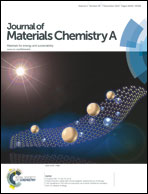Thermochemical heat storage based on the Mn2O3/Mn3O4 redox couple: influence of the initial particle size on the morphological evolution and cyclability†
Abstract
Thermochemical energy storage (TCS) based on reduction–oxidation cycles of multivalent metal oxides is of great interest for concentrating solar facilities, as it can allow enhancing the global plant efficiency and improving the energy generation dispatchability. However, to guarantee the feasibility of the process, selected materials should present long term durability, which requires the evaluation of the redox couple cyclability. In this work we have demonstrated, for the first time, the suitability of the Mn2O3/Mn3O4 pair for this application during 30 cycles, performed in thermobalance. Nevertheless, an appropriate design of such materials is crucial since it has been found that initial particle size influences the redox behaviour of these oxides. Results showed a 2-fold influence of particle size of the as-prepared materials on the redox reversibility. Firstly, this parameter affects to the thermodynamics and kinetics of the redox reactions. Namely a decrease of the particle size shifted the oxidation temperature to lower values and produced slower reduction and oxidation reactions. Secondly, depending on the particles size, samples followed different sintering mechanisms. This fact influenced dramatically the behaviour of the materials with lower particle size, which suffered from a higher degree of densification that eventually caused a total loss of cyclability.


 Please wait while we load your content...
Please wait while we load your content...